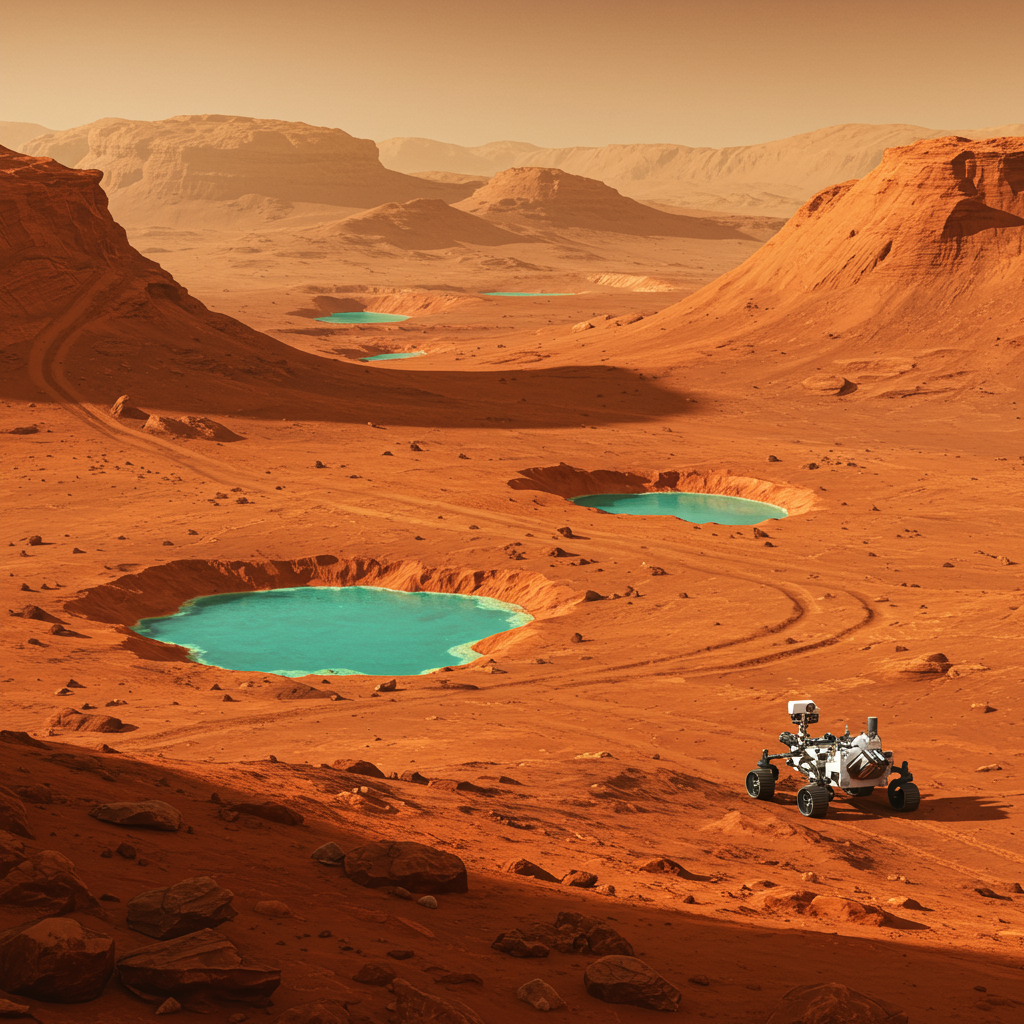Mars, the Red Planet, might not have always been the frigid, barren world we know today. New findings suggest a dynamic past, painting a picture of a fluctuating desert punctuated by temporary oases of liquid water. This groundbreaking research, drawing on data from NASA’s Curiosity rover, offers a compelling new explanation for the planet’s climate history and the ultimate fate of its surface water. Scientists are now exploring how a unique Martian carbon cycle could be the key to unlocking these ancient secrets.
Curiosity Rover Unlocks Mars’ Climate Past
The crucial evidence comes from the Gale Crater, a vast impact basin explored by the Curiosity rover. Researchers, led by Dr. Edwin Kite at the University of Chicago, discovered hidden carbonate minerals within the crater’s rocks. On Earth, carbonates form when atmospheric carbon dioxide reacts with water and minerals, trapping the carbon. Finding significant carbonate deposits on Mars, specifically within Gale Crater’s sedimentary layers, points strongly to a similar process occurring billions of years ago. This discovery is pivotal because it suggests the planet once had active cycles involving atmospheric carbon dioxide and liquid water. Previous evidence hinted at wet and dry periods on ancient Mars, but the driving mechanism remained a mystery. The hidden carbonates discovered by Curiosity now offer a potential solution, suggesting the carbon cycle wasn’t just happening, but actively influencing the planet’s climate.
The Carbon Cycle: A Climate Driver
The research team developed sophisticated climate models spanning 3.5 billion years, based on the assumption that the carbonate record in Gale Crater reflects broader Martian climate cycles. Their models propose a fascinating negative feedback loop centered around the planet’s carbon dioxide. Imagine ancient Mars experiencing a period of warming. This could be triggered by increased solar activity or changes in the planet’s orbit. Warmer temperatures would melt ice, leading to more liquid water forming on the surface and in shallow subsurface environments. This liquid water would then interact with atmospheric carbon dioxide.
As the water mixed with minerals in the rocks, the dissolved carbon dioxide would react, forming solid carbonate compounds. This process effectively pulled carbon dioxide out of the atmosphere, sequestering it within the rocky crust. Carbon dioxide is a potent greenhouse gas, trapping heat and keeping a planet warm. By removing atmospheric CO2, the process would weaken Mars’ greenhouse effect. This reduction in greenhouse gases would cause the planet to cool down and become drier. As temperatures dropped and water became scarcer, the rate of carbonate formation would decrease, eventually stabilizing the cycle. This feedback mechanism created a climate that wasn’t stably warm and wet, but rather fluctuated.
Why Fluctuations, Not Stability?
A key difference between ancient Mars and Earth is volcanic activity. On Earth, geological processes like volcanism continuously return trapped carbon dioxide from the crust back into the atmosphere, maintaining a relatively stable carbon cycle over vast timescales. Mars, being a smaller planet, cooled down much faster than Earth and has significantly less ongoing volcanic activity. This meant that once carbon was trapped in carbonates on Mars, it largely stayed there. There was no efficient planetary mechanism to replenish the atmospheric CO2 that was being locked away. This lack of carbon replenishment prevented Mars from establishing a long-term, stable warm and wet climate. Instead, the climate settled into a fluctuating steady state.
Changes in Mars’ orbit, which are known to be more chaotic than Earth’s, likely played a role in modulating these wet-dry cycles. Orbital variations could influence the distribution and intensity of sunlight, potentially triggering periods where ice melted and liquid water briefly became available, restarting the carbonate formation and cooling feedback loop. This mechanism explains why past water on Mars wasn’t widespread and permanent but was restricted to geographically patchy and temporally intermittent “oases.” The sedimentary layers in Gale Crater, which stretch down approximately 4 kilometers (about 2.5 miles), appear to be a tangible geological record of these repeated wet-dry cycles and the transient nature of surface water. The rocks literally recorded the ebb and flow of ancient Martian water.
The Vanishing Act: Why Mars Dried Up
Even with these cyclical oases, the long-term fate of Mars’ atmosphere was sealed by its lower gravity and lack of a global magnetic field. Over billions of years, the solar wind stripped away much of the Martian atmosphere. As the atmosphere thinned, the atmospheric pressure on the surface dropped dramatically. Liquid water can only exist within a certain range of temperatures and pressures. If the pressure drops too low, water transitions directly from solid ice to gas (sublimation), bypassing the liquid phase entirely. This critical pressure point is known as the “triple point” of water.
The model suggests that as Mars’ atmosphere leaked away over eons, the surface pressure eventually dropped below water’s triple point. Once this happened, liquid water could no longer be stable on the surface. Even if temperatures rose above freezing, any ice would simply turn directly into vapor. This process led to the complete disappearance of stable liquid water, resulting in the cold, dry Mars we observe today. The patchy, intermittent nature of the ancient oases, driven by the carbon cycle feedback, essentially prolonged the existence of liquid water on Mars, but couldn’t prevent its ultimate disappearance once atmospheric pressure fell too low.
While this model offers a compelling explanation supported by Curiosity data, the researchers emphasize it is a testable hypothesis rather than definitive proof. The assumption that the carbonate findings in Gale Crater are representative of ancient Martian processes globally needs further validation. Testing these assumptions will require future surface missions to explore other regions of Mars and search for similar carbonate records. Understanding Mars’ climate history is not just about a single planet; it provides crucial insights into how rocky planets form and evolve, and what conditions are necessary for the potential emergence and sustainment of life elsewhere in the universe.
Frequently Asked Questions
What did Mars’ climate look like in the ancient past?
New research suggests that ancient Mars wasn’t consistently wet or dry, but instead had a fluctuating desert environment. This means vast, arid landscapes were occasionally dotted with intermittent, patchy oases where liquid water temporarily existed. Data from NASA’s Curiosity rover in Gale Crater, specifically the discovery of hidden carbonate minerals, provides key evidence supporting this view of a dynamic, rather than stable, past climate.
How did the carbon cycle on Mars create patchy oases?
Scientists propose a negative feedback loop involving atmospheric carbon dioxide and water. When conditions were warm enough for liquid water to appear, this water reacted with rocks, trapping atmospheric CO2 as solid carbonates. Removing CO2, a greenhouse gas, cooled the planet, reducing liquid water. Because Mars lacked strong volcanism to return trapped carbon to the atmosphere, this cycle prevented a stable warm, wet climate and instead created brief periods of water (oases) before drying out again.
What finally caused liquid water to vanish from Mars’ surface?
Over billions of years, Mars’ atmosphere was gradually lost to space due to its low gravity and lack of a strong global magnetic field. This caused atmospheric pressure on the surface to drop significantly. Eventually, the pressure fell below the “triple point” of water. Below this critical pressure, liquid water cannot exist; water ice turns directly into vapor. This atmospheric thinning ultimately eliminated stable liquid water from the Martian surface, resulting in the cold, dry conditions seen today.
This new perspective, informed by detailed analysis of Martian geology and sophisticated climate modeling, highlights the complex interplay of atmospheric chemistry, geology, and solar/orbital forces that shaped the Red Planet’s destiny. Future missions will be essential to further explore these ancient carbon records and continue unraveling the mysteries of Martian water.
References
- <a href="https://www.theregister.com/2025/07/04/marswasonceadesert/”>www.theregister.com
- <a href="https://www.theregister.com/2025/07/01/nasalunartrailblazer_lost/”>www.theregister.com
- <a href="https://www.theregister.com/2025/06/27/ushurricanesatellitedatato_stop/”>www.theregister.com
- <a href="https://www.theregister.com/2025/06/11/nasatosilencevoyagerssocial/”>www.theregister.com
- <a href="https://www.theregister.com/AMP/2025/07/04/microsoftfinallybidsfarewellto/”>www.theregister.com




